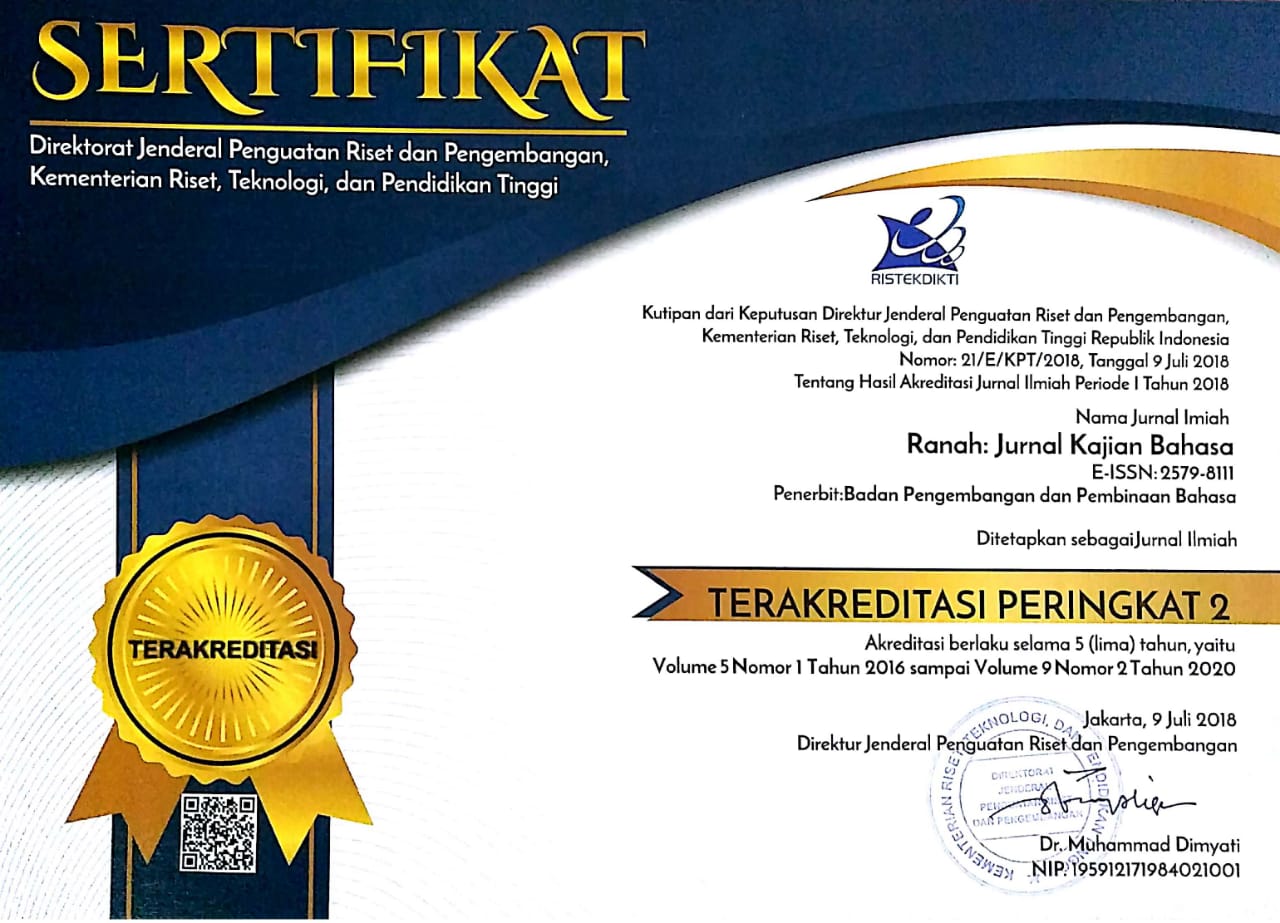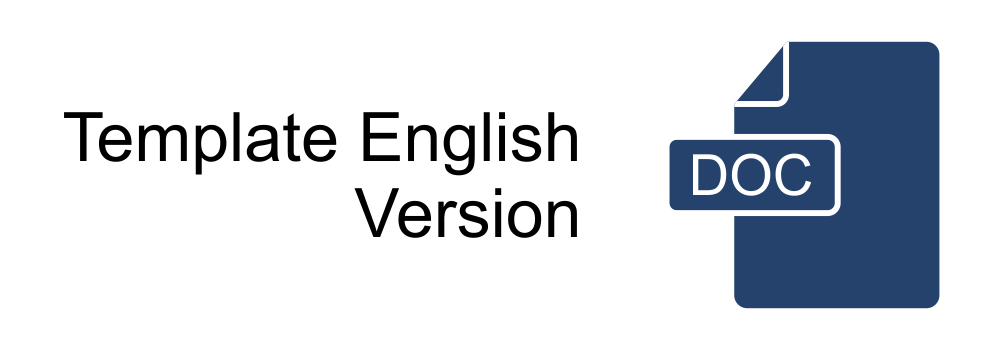Memotret Hoaks Covid-19 di Awal Pandemi Melalui Analisis Wacana Berbasis Linguistik Korpus
Abstract
This study aims to identify the themes, characteristics and aspects behind the Covid-19 hoakses, particularly those appearing in Indonesia at the beginning of the pandemic, i.e March 2020. This study used a qualitative method by involving researchers as research instruments. The analysis was carried out through a critical discourse analysis framework supported by corpus linguistics. The data of this study are the Covid-19 hoaks corpus which has been confirmed as fake news and has been released by TurnBackHoaks.ID website managed by MAFINDO (Indonesian Anti Hoaks Society). The hoakses analyzed in this study were those which appeared sequentially for 16 days, from March 15 to March 31, 2020. The corpus of the Covid-19 hoakses consisted of 94 texts, 2,367 types, and 6,872 tokens, processed by using Antconc software. The analysis of word lists, concordances, and collocations was used to see texts’ composition of Covid-19 hoakses in Indonesia. The word list selected based on the results of corpus processing is the word with the highest frequency in the first to fiftieth rank. The chosen words are those other than prepositions or which is denoted by the symbol (p) in Indonesian Language Official Dictionary. The selection of non-prepositional words aims to facilitate data analysis with more specific keywords. The selected collocations are 1R (one right) and 1L (one left). Word lists and concordance analyses are used to see the tendency of hoaks texts’ content. Meanwhile, the collocation analysis aims to see the composition of words that appear in the Covid-19 hoaks texts. The results of the processing of the Covid-19 hoaks corpus were further deepened with a discourse analysis framework. In particular, the critical discourse analysis framework is used to analyze and explore the social and political context of circulating hoakses, especially hoakses involving the president as a symbol of the state and government. The results show that there are four hoaks themes about the Covid-19 in March 2020 i. e. health (29%), government policies (30%), criticism of President Joko Widodo (13%), and religion (5%). In terms of hoakses on criticism of President Joko Widodo, critical discourse analysis shows that the hoaks maker has the opposite ideology with him. These hoakses can also be seen as a portrayal of the socio-political condition in Indonesia after the 2014 presidential election.
Abstrak
Penelitian ini bertujuan untuk mengidentifikasi tema, ciri dan aspek yang melatarbelakangi kemunculan hoaks-hoaks Covid-19, khususnya hoaks yang muncul di Indonesia pada awal pandemi, yaitu bulan Maret 2020. Penelitian ini menggunakan metode kualitatif dengan melibatkan peneliti sebagai instrumen penelitian. Analisis dilakukan dengan kerangka analisis wacana kritis yang didukung oleh linguistik korpus. Data dalam penelitian ini adalah korpus hoaks Covid-19 yang terkonfirmasi sebagai berita bohong dan telah dirilis oleh situs TurnBackHoaks.ID yang dikelola oleh MAFINDO (Masyarakat Anti hoaks Indonesia). Hoaks Covid-19 yang dianalisis dalam penelitian ini adalah hoaks yang muncul secara berurutan selama 16 hari, yaitu tanggal 15 Maret hingga 31 Maret 2020. Korpus hoaks Covid-19 yang diteliti terdiri atas 94 teks, 2.367 tipe, dan 6.872 token. Korpus diolah menggunakan perangkat lunak Antconc. Analisis daftar kata, konkordans, dan kolokasi digunakan untuk melihat komposisi teks hoaks Covid-19 di Indonesia. Daftar kata yang dipilih berdasarkan hasil pengolahan korpus adalah kata dengan frekuensi tertinggi pada peringkat pertama sampai ke-50. Kata yang dipilih adalah kata selain preposisi atau yang dalam KBBI dilambangkan dengan simbol (p). Pemilihan kata non-preposisi bertujuan untuk mempermudah analisis data dengan kata kunci yang lebih khusus. Kolokasi yang dipilih adalah 1R (satu kanan) dan 1L (satu kiri). Analisis pada daftar kata dan konkordans digunakan untuk melihat kecenderungan isi teks hoaks. Sementara itu, analisis kolokasi bertujuan untuk melihat komposisi kata yang muncul pada teks-teks hoaks Covid-19. Hasil pengolahan korpus hoaks Covid-19 selanjutnya diperdalam dengan kerangka analisis wacana. Secara khusus, kerangka analisis wacana kritis digunakan untuk menganalisis dan mendalami konteks sosial dan politik dari hoaks yang beredar, khususnya hoaks yang melibatkan presiden sebagai simbol negara dan pemerintah. Hasil penelitian menunjukkan bahwa terdapat empat tema hoaks terkait Covid-19 pada Maret 2020, yaitu hoaks bertema kesehatan (29%), kebijakan pemerintah (30%), kritik terhadap Presiden Joko Widodo (13%), dan keagamaan (5%). Terkait hoaks bertema kritik terhadap Presiden Joko Widodo, analisis dengan pendekatan wacana kritis menunjukkan bahwa pembuat hoaks memiliki ideologi yang berseberangan dengan Joko Widodo. Jika dirunut lebih jauh, hoaks-hoaks tersebut juga dapat dipandang sebagai gambaran dari kondisi sosial politik Indonesia pasca pilpres 2014.
Keywords
Full Text:
PDF (Bahasa Indonesia)References
Ahyad, M. R. M. (2017). Analisa Penyebaran Berita hoaks di Indonesia. Jurnal Ilmu Komunikasi, 8(1), 19-32.
Anthony, L. (2011). AntConc. In AntConc (Version 3.2.4) [Computer Software]. Tokyo, Japan: Waseda University. Available from http://www.laurenceanthony.net/.
Aribowo, E. K. (2017). Menelusuri Jejak hoaks dari Kacamata Bahasa: Bagaimana Mendeteksi Berita Palsu Sedini Mungkin. In S. Retnatiti, Rosyidah, & H. A. Bukhori (Eds.), Literasi dalam Pembelajaran Bahasa (Vol. 1, pp. 78--87). Malang: Universitas Negeri Malang. https://doi.org/10.31227/osf.io/k2at4
Bachtiar, Y. C. (2018). hoaks, Media Serta Analisis Wacana. Jurnal Komunikologi (Ilmu Komunikasi), 15(2), 94--101.
Baker, P. (2014). 'Bad wigs and screaming mimis': Using corpus-assisted techniques to carry out critical discourse analysis of the representation of trans people in the British press. In C. Hart & P. Cap (Eds.), Contemporary Critical Discourse Studies (pp. 211-235). Bloomsbury.
Baker, P., Gabrielatos, C., Khosravinik, M., Krzyzanowski, M., McEnery, T., & Wodak, R. (2008). A useful methodological synergy? Combining critical discourse analysis and corpus linguistics to examine discourses of refugees and asylum seekers in the UK press. Discourse and Society. https://doi.org/10.1177/0957926508088962
Balfour, J. (2020). A corpus-based discourse analysis of representations of people with schizophrenia in the British press between 2000 and 2015. Lancaster University. https://doi.org/10.4324/9780429259982-31
Balliu, C., Besien, F. Van, Bahadır, Ş. (2007). Using collocation analysis to reveal the construction of minority groups The case of refugees, asylum seekers The RASIM Corpus 1996. Meta: Journal Des Traducteurs.
Chen, M., & Flowerdew, J. (2018). Introducing data-driven learning to PhD students for research writing purposes: A territory-wide project in Hong Kong. English for Specific Purposes. https://doi.org/10.1016/j.esp.2017.11.004
Dani Prabowo. (2019). Pengguna Medsos Tinggi, Berita" hoaks" Semakin Mudah Menyebar - Kompas.com. Kompas.Com.
Ditjen Aptika Kemenkominfo. (2020). Kominfo Temukan 1.401 Sebaran Isu hoaks terkait Covid-19. Retrieved September 16, 2020, from https://aptika.kominfo.go.id/2020/05/kominfo-temukan-1-401-sebaran-isu-hoaks-terkait-covid-19/
Fairclough, N. (1995). Critical Discourse Analysis: The Critical Study of Language. New York: Longman.
Fajri, M. S. Al. (2019). The discursive portrayals of Indonesian Muslims and Islam in the American press: A corpus-assisted discourse analysis. Indonesian Journal of Applied Linguistics, 9(1), 167-176. https://doi.org/10.17509/ijal.v9i1.15106
Fajri, M. S. Al. (2020). The Construction of Indonesian Muslims and Islam in Australian Newspapers: A Corpus-Assisted Critical Discourse Analysis. Discourse and Interaction, 13(1), 5-24. https://doi.org/10.5817/DI2020-1-5
Fatmawati, S., Salzabila, R., & Rizkitama, G. A. (2019). Analisis Berita hoaks Di Korpus Sosial Media Guna Mengembangkan Model "Kapak hoaks" (Kemandirian Pembaca Menganalisis Konten hoaks) Studi Analisis Wacana Kritis. LITE, 15(2), 113--135. https://doi.org/10.33633/lite.v15i2.2525
Gabrielatos, C., & Baker, P. (2008). Fleeing, sneaking, flooding: A corpus analysis of discursive constructions of refugees and Asylum Seekers in the UK Press, 1996-2005. Journal of English Linguistics. https://doi.org/10.1177/0075424207311247
Hizbullah, N., Fazlurrahman, & Fauziah, F. (2016). Linguistik Korpus dalam Kajian dan Pembelajaran Bahasa Arab di Indonesia. Konferensi Nasional Bahasa Arab (KONASBARA) II.
Islamiah, M., & Fajri, M. S. Al. (2019). Skinny, Slim, dan Thin: Analisis Berbasis Korpus Kata Sifat Identik dan Implikasinya Pada Pengajaran Bahasa Inggris. Ranah: Jurnal Kajian Bahasa, 8(1), 19-32. https://doi.org/10.26499/rnh.v8i1.894
Kleinberg, B., Vegt, I. Van Der, Arntz, A., & Verschuere, B. (2019). Detecting deceptive communication through linguistic concreteness. https://doi.org/10.31234/osf.io/p3qjh
Kumar, S., West, R., & Leskovec, J. (2016). Disinformation on the web: Impact, characteristics, and detection of wikipedia hoakses. 25th International World Wide Web Conference, WWW 2016. https://doi.org/10.1145/2872427.2883085
Kusno, A., & Bety N. (2017). Analisis Wacana Kritis Cuitan Fahri Hamzah (FH) terkait Hak Angket Komisi Pemberantasan Korupsi (KPK). Ranah: Jurnal Kajian Bahasa. 6(2), 137-159. doi: https://doi.org/10.26499/rnh.v6i2.462
Mautner, G. (2009). Corpora and critical discourse analysis. In Paul Baker (Ed.), Contemporary Corpus Linguistics (pp. 32-46). Bloomsbury.
Panji, A. (2017). Media Sosial Jadi Saluran Favorit Sebar hoaks. Retrieved from https://kumparan.com/aditya-panji/media-sosial-jadi-saluran-favorit-penyebaran-hoaks/full
Pennycook, G., Mcphetres, J., Zhang, Y., & Rand, D. G. (2020). Fighting COVID-19 misinformation on social media: Experimental evidence for a scalable accuracy nudge intervention. Psychological Science, 31(7), 770--780. https://doi.org/10.1177/0956797620939054
Puspitasari, D. A. (2022). Corpus-Based Speech Act Analysis on the Use of Word 'Lu' in Cyber Bullying Speech. In A. F. Muntazori, M. Rifqi, N. Amzy, & S. Setiawati (Eds.), KIBAR 2020 (pp. 1-10). EAI. https://doi.org/10.4108/eai.28-10-2020.2315314
Puspitasari, D. A., & Okitasari, I. (2021). Analisis Tindak Tutur Berbasis Korpus Pada Tagar Tolak Omnibus Law. Bahtera: Jurnal Pendidikan Bahasa dan Sastra, 20(1), 1-14. https://doi.org/10.21009/bahtera.201.01
Rahayu, R. N., & Sensusiyati. (2020). Analisis Berita hoaks Covid - 19 Di Media Sosial Di Indonesia. Jurnal Ekonomi, Sosial, & Humaniora.
Salsabila, A., & Suhardijanto, T. (2020). Sentiment Analysis on Indonesian Political hoakses. In Proceedings of the International University Symposium on Humanities and Arts (INUSHARTS 2019) (Vol. 453, pp. 15-21). Atlantis Press. https://doi.org/10.2991/assehr.k.200729.004
Septanto, H. (2018). Pengaruh hoaks dan Ujaran Kebencian Sebuah Cyber Crime dengan Teknologi Sederhana di Kehidupan Sosial Masyarakat. Jurnal Sains Dan Teknologi.
Sukma, A. E. (2019). Critical Discourse Analysis on the hoaks Phenomenon of the Politicians' Social Media Posts in Approaching the Presidential Election 2019. Universitas Muhammadiyah Sumatera Utara.
Sukma, B. P. (2018). Analisis Wacana Kritis Kabar Bohong (hoaks) melalui Literasi Media. Telaga Bahasa, 6(2), 521--532.
Sukma, B. P. (2020). Appraisal System Pada hoaks Terkait Covid-19: Upaya Awal Menyelisik Cara Dan Motif Penyebaran hoaks. In S. Lubna & Y. Yulianti (Eds.), Seminar Hasil Penelitian Kebahasaan dan Kesastraan "Selisik Bahasa dan Sastra Indonesia" (pp. 3-4). Pontianak: Balai Bahasa Provinsi Kalimantan Barat.
Syaefullah, F., & Perdana, A. (2019). Critical Discourse Analysis of Hoaks on Primordial Issues in the Jakarta Gubernatorial Election 2017. In Setiajid, N. Arumsari, W. E. Septina, & M. H. Susanti (Eds.), Proceedings of the 1st International Symposium on Indonesian Politics. Semarang: EAI. https://doi.org/10.4108/eai.25-6-2019.2287981
Ta'abudi, D. H. (2018). Model Klarifikasi Berita hoaks dalam Rubrik "hoaks atau Bukan" Koran Jawa Pos Bulan Oktober 2017. In E. & Djamari (Ed.), Seminar Nasional Bahasa dan Sastra: Mengukuhkan Fungsi Bahasa dan Sastra untuk Memperkuat Jati Diri Bangsa (pp. 683--694). Jakarta: LIPI Press.
Utami, P. (2018). hoaks in Modern Politics: The Meaning of Hoaks in Indonesian Politics and Democracy. Jurnal Ilmu Sosial Dan Ilmu Politik, 22(2), 85-97. https://doi.org/10.22146/jsp.34614
Utami, M.A. (2018). Representasi LGBT dan Ideologi Tersembunyi dalam The Jakarta Post dan Jakarta Globe. Ranah: Jurnal Kajian Bahasa. 7 (1), 86-114. https://doi.org/10.26499/rnh.v7i1.566
Ubaidillah, & Hartanto, A. (2020). Disinformasi Keagamaan di Indonesia: Tinjauan Wacana. Jurnal Masyarakat dan Budaya, 22(3), 97--110. https://doi.org/10.14203/jmb.v22i3.1107
Vamanu, I. (2019). Fake News and Propaganda: A Critical Discourse Research Perspective. Open Information Science, 3, 197-208. https://doi.org/10.1515/opis-2019-0014
van Dijk, T. A. (1993). Principles of Critical Discourse Analysis. Discourse & Society, 4(2), 249-283. https://doi.org/10.1177/0957926593004002006
Wardani, M. M. S. (2017). Manipulasi Bahasa dalam Teror Kabar Bohong (hoaks). Jurnal Ilmiah Kebudayaan SINTESIS, 11(2), 87-94.
Wodak, R. (2001). What CDA is about - a summary of its history, important concepts and its developments. In R. Wodak & M. Meyer (Eds.), Methods of Critical Discourse Analysis (pp. 1--13). London: SAGE Publications. https://doi.org/10.4135/9780857028020.n1
Wodak, R., & Meyer, M. (2009). Methods of critical discourse analysis (2nd ed.). California, CA: SAGE Publication Ltd.
DOI: https://doi.org/10.26499/rnh.v11i2.5152
Refbacks
- There are currently no refbacks.








